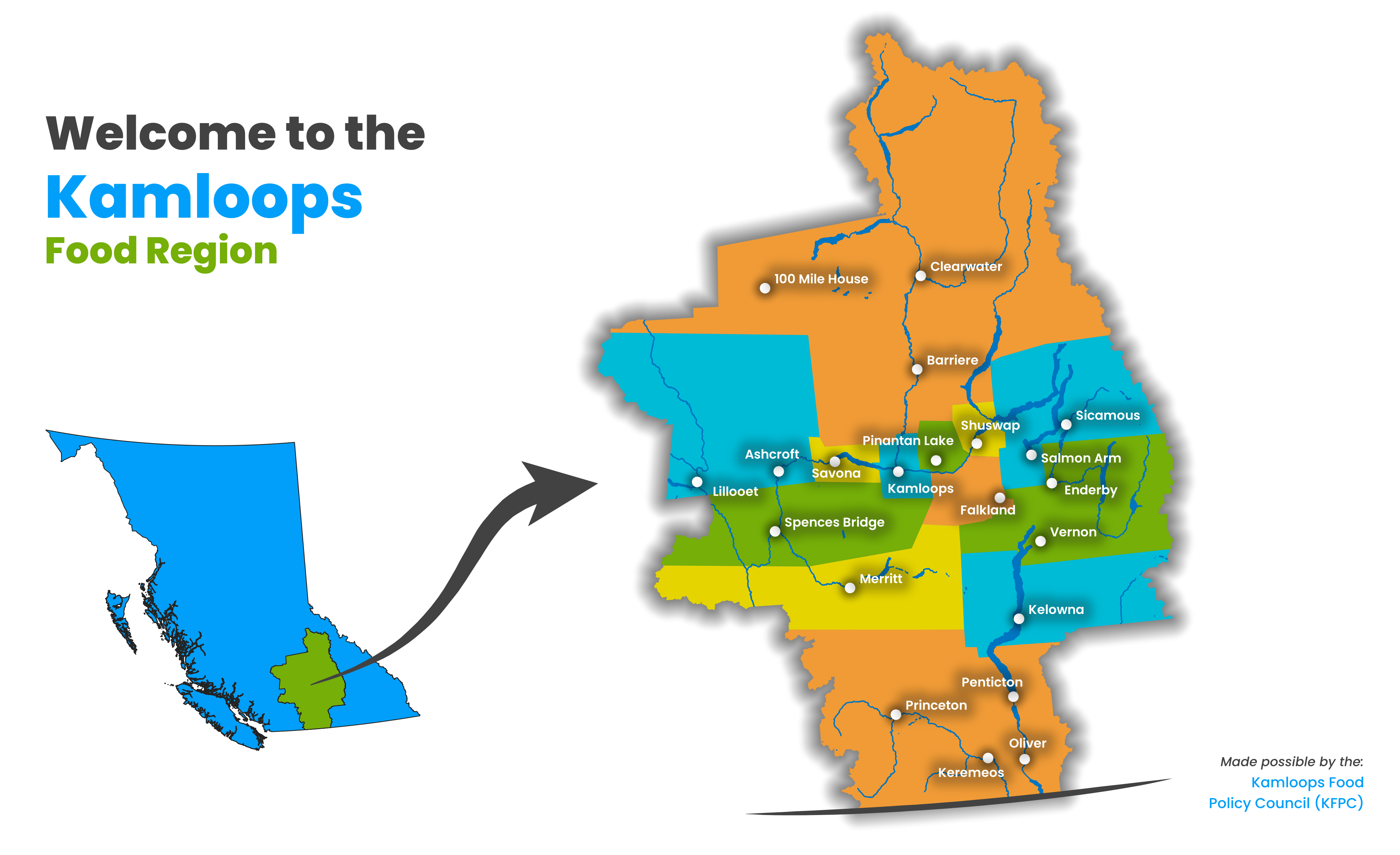
The Kamloops region features grasslands, rolling hills, and rugged terrain; creating a diverse agricultural environment. This region, with its unique climatic conditions and strategic location, holds significant potential for developing a robust, sustainable food system.
About the Kamloops food region
The Kamloops region of British Columbia, located in the southern interior of the province, presents a unique blend of landscapes and cultural heritage, shaping its distinct challenges and opportunities in the food supply chain.
Geographical and Climatic Features
Kamloops, often referred to as the meeting point of the North and South Thompson rivers, is characterized by its semi-arid climate, distinct from the rainforests typically associated with much of British Columbia. This climate contributes to a landscape that includes grasslands, rolling hills, and rugged terrain; creating a diverse agricultural environment. The region’s climate is favorable for growing a variety of crops, especially those that thrive in dryer conditions.
Agricultural Diversity
The area around Kamloops is known for its agricultural productivity. The warm, dry climate supports a range of agricultural activities, including cattle ranching, which has a long history in the region. Additionally, the area has seen growth in vineyards and wineries, capitalizing on the favorable growing conditions for grapes. Fruit and vegetable farming are also significant, with local markets and farm-to-table initiatives gaining popularity.
Challenges in the Food Supply Chain
In the Kamloops region of British Columbia, the challenges within the food supply chain are multifaceted and deeply intertwined with the area’s unique geography and climate. Water management emerges as a critical issue due to the semi-arid conditions, necessitating efficient and sustainable practices to ensure the viability of agriculture, particularly for crops and livestock reliant on irrigation. While partly eased by Kamloops’ strategic location at the confluence of major highways and rail lines, transportation logistics still pose difficulties, especially for smaller producers in more remote areas. These logistical hurdles impact the distribution and marketing of local produce, affecting the ability of these producers to access broader markets. Economic factors further compound these challenges, as local farmers strive to compete with larger, more industrialized agricultural operations while navigating the complexities of small-scale farming and market dynamics.
Moreover, the looming shadow of climate change adds layer of complexity to the food supply chain. As the region faces more extreme weather events and potential shifts in growing seasons, the traditional agricultural patterns are disrupted, threatening food security. Integrating the region’s rich cultural tapestry, including its significant Indigenous communities, into the agricultural and food production practices is also crucial. This integration not only respects and preserves cultural heritage, but also opens avenues for more sustainable and holistic approaches to farming and food distribution. Addressing these challenges requires a concerted effort to develop innovative, sustainable solutions that are inclusive of the diverse community needs and environmental considerations unique to the Kamloops region.
The Kamloops region, with its unique climatic conditions and strategic location, holds significant potential for developing a robust, sustainable food system. Efforts to enhance water management, support local producers in accessing markets, and integrate sustainable and culturally inclusive practices can help in overcoming the challenges faced by the food supply chain. By focusing on these areas, Kamloops can strengthen its role as a key player in British Columbia’s diverse agricultural tapestry.
About the Kamloops Food Policy Council
With over 25 years of work, the KFPC has become an essential organization to the health and well-being of Kamloops and the surrounding region. Established in 1995 with the intention of addressing high levels of food insecurity in our city, the KFPC continues to expand its reach and network to develop and strengthen food systems work in Kamloops. Through our various food action programs, community partnerships, policy advocacy, and public engagement activities, we work towards our vision of a local food system that is regenerative, sovereign, and just. We know that being able to feed ourselves from our own backyard increases our resilience in the face of climate change and reduces our overall carbon footprint.
Through a collaborative leadership structure of staff, contractors, an elected board, community partnerships, donors, and a robust network of members and volunteers, our organization addresses key issues within the food system continuum, building capacity, partnerships, programs, and policy surrounding food.
Examples of some of KFPC’s current initiatives include: